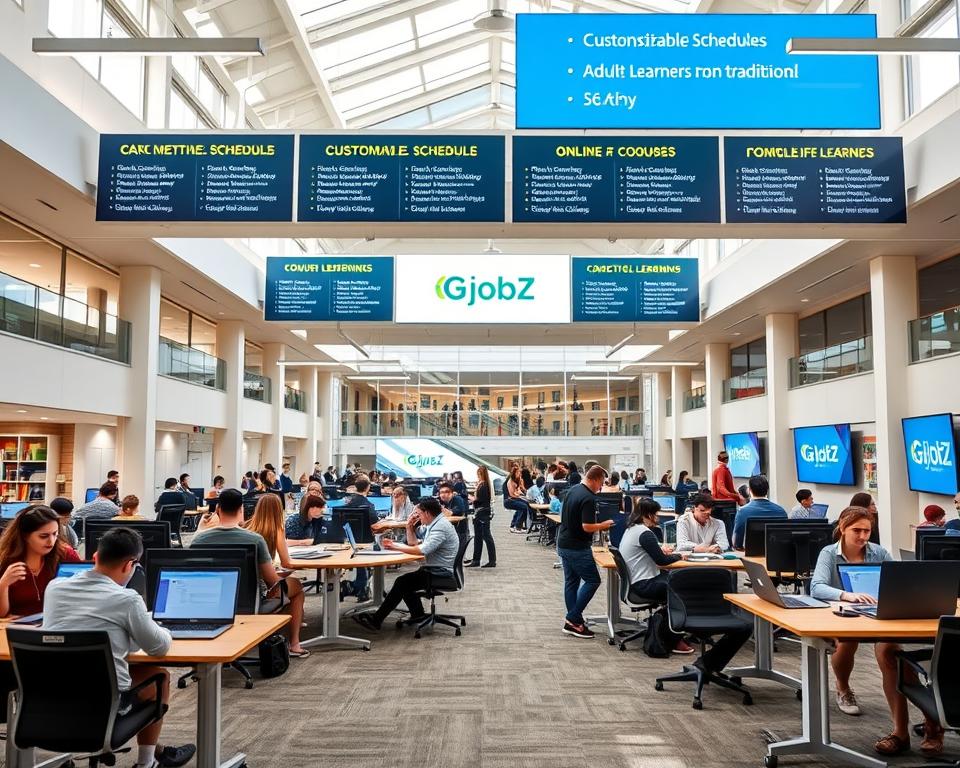
Cost-effective reskilling programs for non-traditional learners
By 2030, 39% of workforce skills will need an upgrade, according to the World Economic Forum. The job market is changing fast, and many workers need flexible ways to stay competitive. Microcredentials and short-term training offer a smart solution.
Today, 90% of students say professional certificates help them stand out to employers. Short courses and stackable credentials provide practical, employer-aligned training. This approach makes education more accessible for those balancing work and learning.
With 76% of learners preferring programs that include industry-recognized credentials, targeted training is reshaping career opportunities. These flexible options help bridge skill gaps without the time and cost of traditional degrees.
Key Takeaways
- Nearly 40% of workforce skills will need updates by 2030.
- Professional certificates help job seekers stand out to employers.
- Most students prefer programs with industry microcredentials.
- Short-term training offers a faster path to career growth.
- Stackable credentials provide flexible learning options.
Who Are Non-Traditional Learners?
Over 60% of young adults are choosing alternatives to four-year degrees, according to Peterson’s Data. These adult learners include working professionals, career changers, and returning students who bring real-world experience to their education. Their diverse backgrounds often enhance problem-solving skills in workplace roles.
Defining the Modern Adult Student
Today’s students prioritize flexibility. Many balance jobs, caregiving, and higher education, making traditional college enrollment impractical. With 68% of workers recognizing industry changes, short-term training fits their needs better than lengthy degree programs.
Common Challenges Faced by Non-Traditional Learners
Despite their motivation, adult learners face hurdles:
- Time constraints: Juggling work, family, and classes leaves little room for extra commitments.
- Financial barriers: Tuition costs and limited financial aid options strain budgets.
- Isolation: Many lack tailored support networks, unlike traditional campus-based students.
These challenges highlight why institutions must adapt to serve this growing segment in higher education.
Types of Cost-Effective Reskilling Programs
Tech giants like Google and IBM are reshaping education with short-term training. These alternatives offer skills aligned with industry needs, often at a fraction of traditional college costs. From digital badges to employer partnerships, learners gain flexibility without sacrificing quality.

Microcredentials and Stackable Certifications
Google’s IT Support Certificate proves short-term training opens doors. Graduates land tech roles through platforms like CareerCircle. Stackable credentials from institutions like National University let learners build toward degrees incrementally.
72% of employers prioritize candidates with microcredentials
Online and Hybrid Learning Platforms
Coursera and edX deliver online education for under $500 per course. These platforms blend self-paced lessons with mentorship, ideal for busy professionals. Costs are often 80% lower than campus-based programs.
Employer-Sponsored Training Initiatives
Amazon’s upskilling programs cover tuition for in-demand skills. IBM partners with universities to tailor courses for the workforce. Such initiatives remove financial barriers while keeping training relevant.
Benefits of Reskilling for Career Advancement
Career growth now hinges on continuous learning and upskilling in fast-changing fields. With 72% of workers crediting alternative credentials for promotions, targeted training unlocks measurable outcomes. Employers increasingly seek candidates who align with evolving industry needs.

Increased Earning Potential and Job Mobility
Short-term certifications deliver tangible salary boosts. Cybersecurity credential holders see 25% higher earnings on average, while data analysis certifications increase pay by 18%. These credentials also enable lateral moves—45% of professionals pivot to AI roles after completing specialized courses.
95% of employers value microcredentials as proof of relevant skills
Aligning Skills with Industry Demands
Partnerships between educators and corporations ensure training meets industry needs. Amazon’s AI curriculum, co-designed with universities, prepares employees for automation-driven roles. Healthcare and tech sectors show the highest demand, with 87% of executives reporting urgent skill gaps.
- Faster ROI: Certifications take 3–6 months versus 4-year degrees, with 60% lower costs.
- Flexible pathways: Stackable credits allow incremental career advancement.
- Employer validation: IBM’s digital badges signal readiness for cloud computing roles.
Overcoming Barriers to Reskilling Success
Adult learners often face time and financial constraints when pursuing new skills. With 80% of employers valuing certificates, tackling these hurdles is critical for career growth. Smart strategies and support systems can turn challenges into opportunities.

Smart Scheduling for Busy Professionals
Block scheduling boosts productivity by 17%, per Peterson’s Data. Prioritize tasks using frameworks like the Eisenhower Matrix:
- Urgent & Important: Dedicate focused blocks for coursework.
- Not Urgent but Important: Schedule skill-building during low-energy hours.
Apps like Trello or Google Calendar help visualize commitments. Short, daily learning sessions (
Funding Your Education Without Debt
Financial aid options extend beyond FAFSA. Compare alternatives in this table:
| Option | Coverage | Eligibility |
|---|---|---|
| Employer Tuition Reimbursement | Up to $5,250/year tax-free | Check company HR policies |
| State Workforce Grants | 100% of program costs | Residency + career field |
| Industry Scholarships | $500–$2,000 | Enrollment in targeted programs |
“Competency-based models credit prior experience, cutting costs by 40%.”
Platforms like O*NET align credentials with local job demand. This support ensures training leads to tangible goals.
How Institutions and Employers Support Non-Traditional Learners
Higher education institutions are adapting to meet the needs of working adults through innovative solutions. With 30%+ of U.S. students enrolled in online courses, flexibility is now a cornerstone of modern learning. Partnerships between colleges and employers ensure training delivers real-world value.

Flexible Scheduling and Prior Learning Assessments
Weekend MBA programs and evening classes cater to professionals. Virtual labs and self-paced modules boost accessibility. Key adaptations include:
- Prior Learning Assessments (PLA): Grant credits for military or work experience, cutting degree time by 40%.
- Asynchronous tools: Platforms like Coursera offer 24/7 access to coursework.
National University integrates microcredentials into degree programs, letting learners stack credentials incrementally.
Corporate Partnerships for Targeted Skill Development
Amazon’s Machine Learning University collaborates with higher education institutions to design AI curricula. IBM’s digital badges validate cloud computing skills. These corporate partnerships address industry gaps while reducing costs for students.
“90% of employees stay longer when employers invest in their development.”
Fortune 500 companies like Walmart and Target offer tuition reimbursement, covering up to $5,250 annually. This support bridges the gap between education and employment.
Conclusion: Embracing the Future of Lifelong Learning
Lifelong learning is no longer optional—it’s a career necessity. With 1.4M workers needing updated skills by 2026, stackable credentials bridge gaps faster than traditional degrees. These microcredentials deliver measurable ROI, with 39% of the workforce requiring skill upgrades by 2030.
Policy changes, like expanded Pell Grant eligibility, could democratize access. Meanwhile, AI-driven platforms will personalize learning, making education more adaptive. Cross-sector collaboration between employers and higher education institutions ensures training aligns with real-world needs.
The future belongs to those who adapt. Leverage tools like Peterson’s Database to identify high-growth opportunities. Start small—stack skills, pivot smartly, and thrive in tomorrow’s workforce.